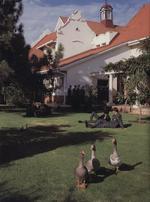Kimberley Railway

It was the railway built in Kimberley that - metaphorically if not actually - brought Kimberley High School into existence. Before the first train pulled in to Kimberley in 1885, the little town was something of a backwater. The railway linked Kimberley to the mainstream of the British Empire, and before long the town could boast some of the most modern amenities of the time.
Then, when Kimberley could no longer be written off as a remote outpost of the Empire, the townsfolk began realising that their town was lagging far behind others in the matter of education, and that it was high time that a secondary school was established. Accordingly, a public meeting chaired by the mayor, Alexander McGregor, was held, at which a board of management was elected, and the same evening the board resolved that a first-class nondenominational school for the children of Kimberley should be established as soon as possible.
Once the decision had been taken, no time was wasted. Temporary premises were found - a wood and iron church building attached to the Trinity Wesleyan Church for the girls, and an empty warehouse in De Beers Road for the boys. Teaching posts were advertised and within a few months principals had been hired for both schools: William A Norrie for the boys' school and Eliza L Redford for the girls'. The schools opened in 1887, and the enrolments stood at 21 girls and 34 boys.
First Headmaster
By the end of that 1887 the respective enrolments at the schools were 122 and 127, and by April the following year their permanent homes in Lanyon Terrace had almost been completed. The two schools stood on either side of a single building which served as a central school hall; at either end of each set of classrooms was the office of the principal, that of the headmaster to the right and that of the headmistress to the left. However, enrolment was increasing at such a dramatic rate that no sooner had the pupils moved into their new home than alterations had to be made. More classrooms were built on, to form extensions at right angles to the original linear building, leaving the street facade intact. The building, very much a utilitarian one, and of limited architectural merit, was restored in 1987 and today serves as the Kimberley Teachers' Centre, its appearance unchanged since its erection except that the brick walls are now plastered and painted.
Headmaster William Norrie played a part in establishing the Kimberley cadet corps, in 1891, after which he appeared to run out of energy, and in 1893 he resigned. His replacement, 31-year-old Impold Complin Wilkes proved a real find for Kimberley High School: besides his academic excellence and managing ability, he was a fine sportsman, and he brought to the young school the energy that had been lacking towards the end of Norrie's tenure.
Sporting Legends
Headmaster Wilkes was the inspiration behind numerous improvements to Kimberley High School for boys. He was instrumental in obtaining updated physical science equipment, and two-pupil desks to replace the uncomfortable eight-seaters of before; he established a library; and he introduced both Dutch and music lessons as part of the curriculum. Under Wilkes organised sport was started: cricket, athletics, soccer and rugby were all played on the fields of the nearby Town Gardens.
It was in these early days that the school produced eight rugby Springboks, including the now legendary FJ ('Uncle') Dobbin, considered by some to be the finest flyhalf of them all, who was to play for South Africa from 1903 to 1913. Very few other schools can boast this number of Springboks produced in their entire history. In all, Kimberley Boys' High School has produced 62 Springboks, 21 of them rugby players, and the others running the gamut of sports from barefoot waterskiing through clay-pigeon shooting to weightlifting.
Sport is not the only area in which the school's Old Boys have excelled, however, and a large number of the boys grew into men intent on serving others, among them former member of parliament and mayor of Johannesburg Dave Marais; one-time mayors of Vredenburg Henry Flylink and Harry Walker; and past mayors of Kimberley itself, Wilfred Orr, Gus Haberfeld, Lionel Jawno and Canon George Pressly, who taught at the school from 1954 until he retired in 1983.
A Thriving School
British scholar Henry Clement Notcutt had in 1865 come to South Africa to teach at the South African College Schools in Cape Town. It was while he was there that his application as headmaster of Kimberley High School was approved. More aloof than Wilkes, he was very much the academic and intellectual. The first thing he had to deal with after he had taken up his post was the outbreak of the South African War and the subsequent Siege of Kimberley.
The town was surrounded by Boer forces and effectively cut off from the outside world; food was in desperately short supply. The school was closed - much to the delight of many a small boy - and then, towards the end of the siege, was commandeered for use as a military hospital. The siege was lifted in February 1900, but the school could not be reopened until April, after the army had vacated it.
After only four years at the school Notcutt left, in 1903, to take up the chair of English at Victoria College, later to become Stellenbosch University. He left behind a thriving school with a healthy and growing enrolment, and such innovative additions as a woodwork and drawing room and a chemical laboratory.